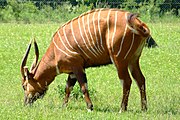Halaler
Parks and nature
Halaler is located on the eastern coast of the province of Fidakar. It sits on the estuary of the Ubrahamahan River, which is widely considered one of the mother rivers of Packilvania because it supplies water and enables navigation for ships coming from the interior of the country. It has several tributaries on which large dams have been constructed to provide clean water and hydroelectric power for the city as well as other cities in the vicinity. Additionally much of the area along the Ubrahamahan River and the dams and lakes of its tributaries is protected under nature reserves which gives the citizens access to the outdoors.
The city is built on and around wetlands. As the city has developed and modern sensibilities around nature conservation have embedded themselves into urban planning policies, the city has developed and enforced regulations to limit the impact of sentient development on the natural environment. As such, there are several large parks, protected wetlands and other natural areas within the city that house species of birds, mammals, reptiles, fish and amphibians. The city has won recognition from international and domestic urban design, landscaping and sustainability awards for its efforts to preserve its natural environment. In the 2023 Nature and Urbanism Index published by the Crescent, Halaler was declared the most naturally beautiful and ecologically sustainable city in Packilvania, for the 5th year in a row.
The largest park located within the city limits of Halaler is the Hubdeen Wetland Park which is surrounded by the Hubdeen Smart City, a joint venture between the city government and private developers that houses over 100 species of birds including cormorants, herons, storks, shoebills, Guinea fowl, kingfishers and hornbills. Whereas the Hubdeen Wetland Park was built in the 21st century, the second largest park fully within the city is the Sultan Zygros II Imperial Garden which was created by diverting water from the Yubrahanahad River into the Hanafiya Lake in the 16th century by Sultan Zygros II. He commissioned several pavilions and palaces to be built within the Imperial Garden that currently serve as museums and public recreational spaces. The Sultana Zerah Demir III Botanical and Zoological Garden is not entirely located in the city, but it is one of the largest zoos in the country by the number of animals species housed there whose species include over 70 antelope, 81 primates, 156 birds and 140 reptiles.
Libraries, museums and galleries
Many of the palaces and castles that were built by wealthy merchants, aristocracy and royalty have been converted to museums, galleries and libraries. The Fidakar Royal Palace is the former seat of the court of the Kingdom of Fidakar that was abandoned by the Demir dynasty in favour of the Halaler Imperial Palace. Today it serves as the location of a museum and gallery that houses works of art by renowned painters such as Kharyad a-Nakhousar, Elahid a-Yakhanad and the Victory of the Golden Host ceiling mural by Durayn a-Jubrameed. The Halalerian Metropolitan Museum of Contemporary Art was built in the early 20th century and houses thousands of works of art including exhibitions that have included works by Ilhamed Axunkeraan and the infamous the Emperor's Great Folly which was controversial for implying that Sultan Amhoud I was the cause of the nuclear strike in Ashmariya.
The Grand City Library is one of the largest archives of written works in the Packilvanians and Fidakarian languages in the world. It forms part of a network of private and public libraries including the Royal Fidakarian Library maintained by the University of Halaler and the Mansuwar Thekhnad People's University named for the Fidakarian Communist Party Secretary at the time of its construction. The city also plays host to the Halaler Mobile Book Network which consists of hundreds of stations in various public places where citizens can borrow, donate and return books. Over 250 such stations have been installed throughout the city especially in low income areas to give the people access to books.
Transport
The city is served by the Halaler International Airport which is the hub of regional and domestic airlines such as Phoenix Air and Southeast Packilvanians Airlines. The city is connected by a network of buses which is run on the basis of a franchise model under the broader Yadhaabeki Halaler Bus Network. It benefits from over 80 kilometres of dedicated bus lanes. The city also has 100 kilometres of freight and passenger rail including a mix of trains that span all the way to the city limits and connect it with neighbouring towns. The train network is operated by the Halaler City Rail. Over 18 kilometres of cable cars have been erected to provide views of the city. The city connects to Gezer and Vashtoon via the N4 highway, to Ubran via the FR1 highway and to Yashood via the FR2 highway. The city has over 200 kilometres of bicycle and pedestrian pathways and the Halaler Central Business District and the Halaler Waterfront District and the Old City are largely free of cars.
History
The area that comprises modern day Halaler was inhabited by a civilisation of nomads who travelled by raft along the coast to catch fish at least around 20,000 BCE. They would sometimes shelter in the caves along the shore. Rafts were found that were preserved in solidified volcanic ash as the flow of molten rock from the surrounding volcanic mountains.
The




